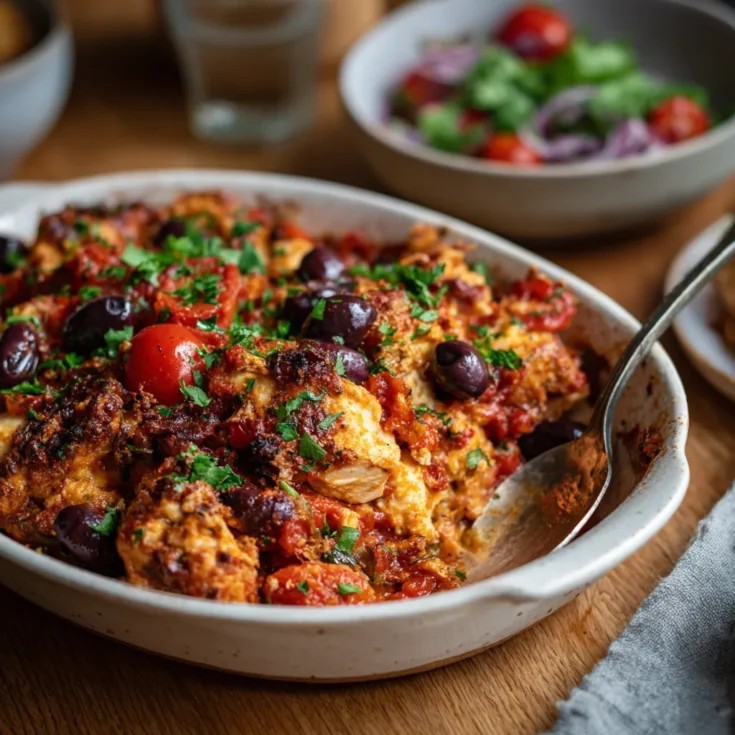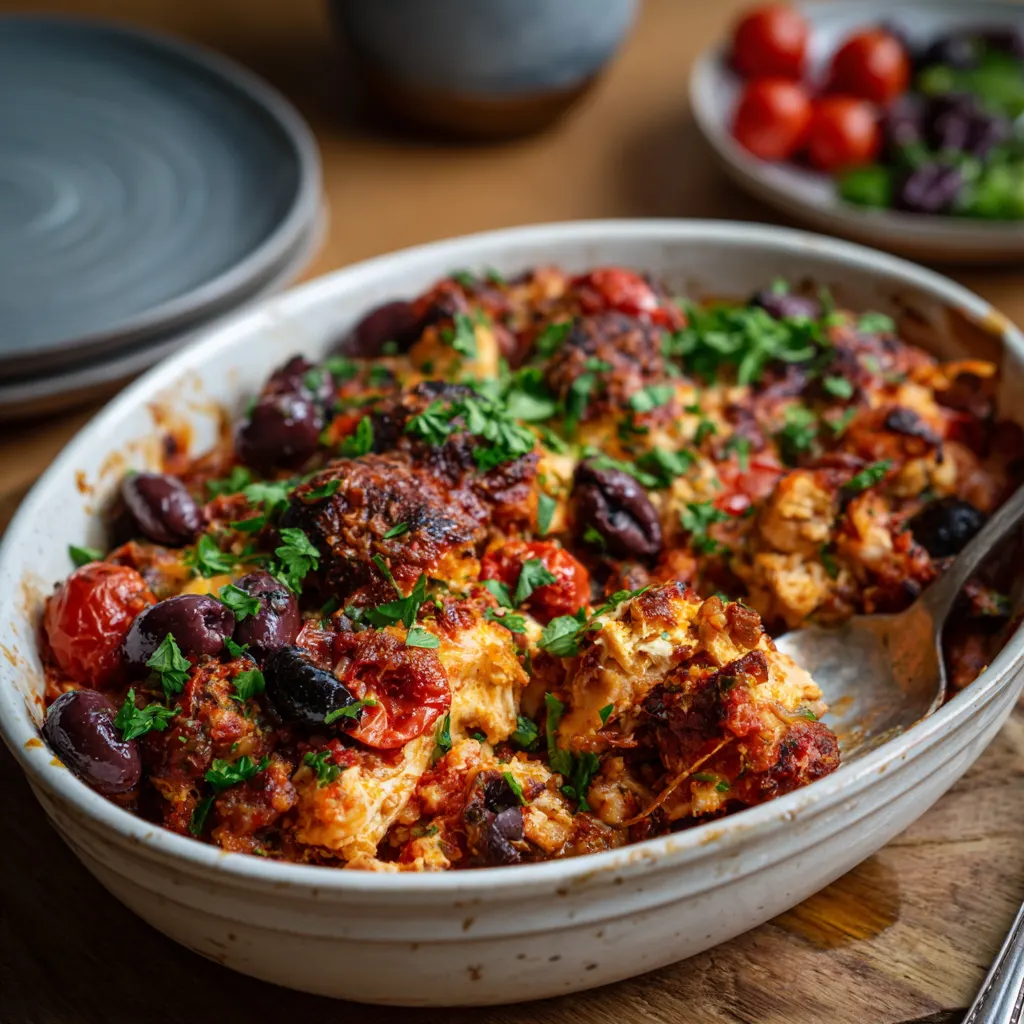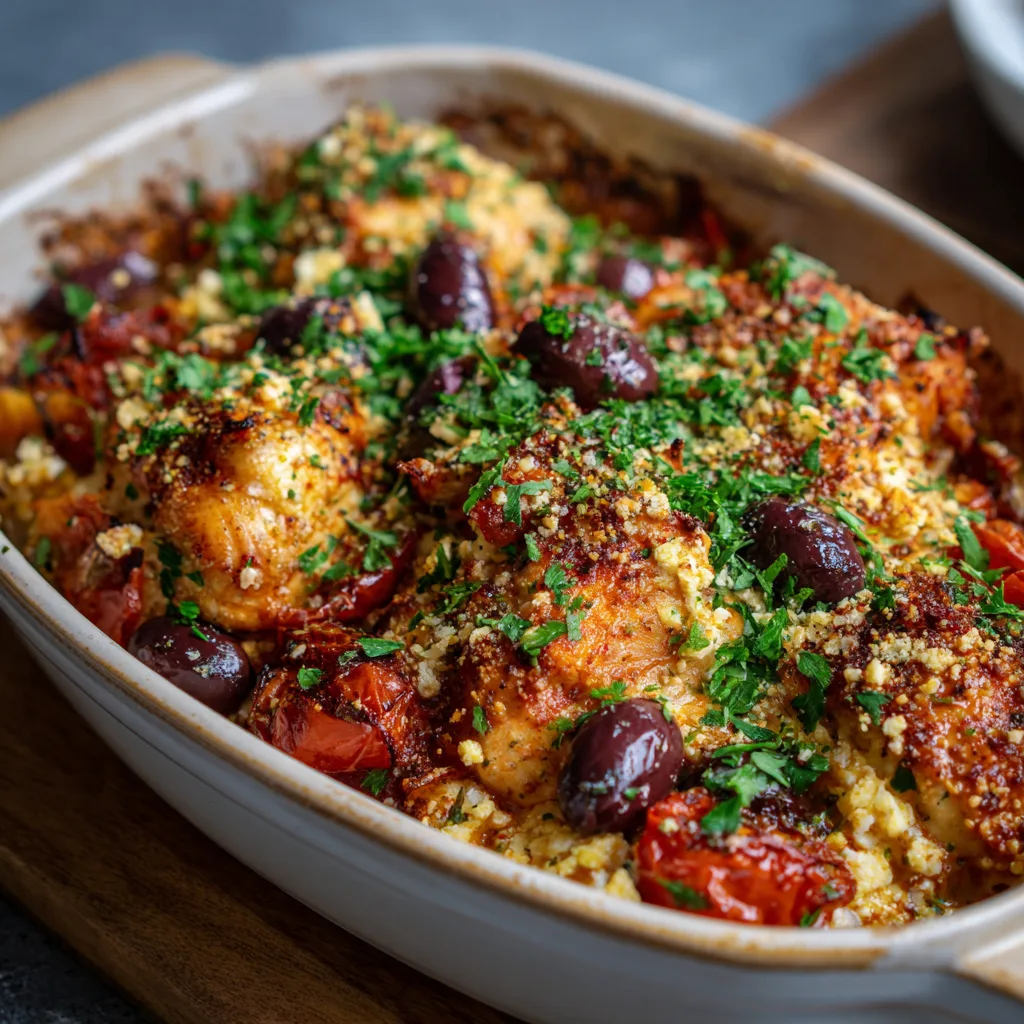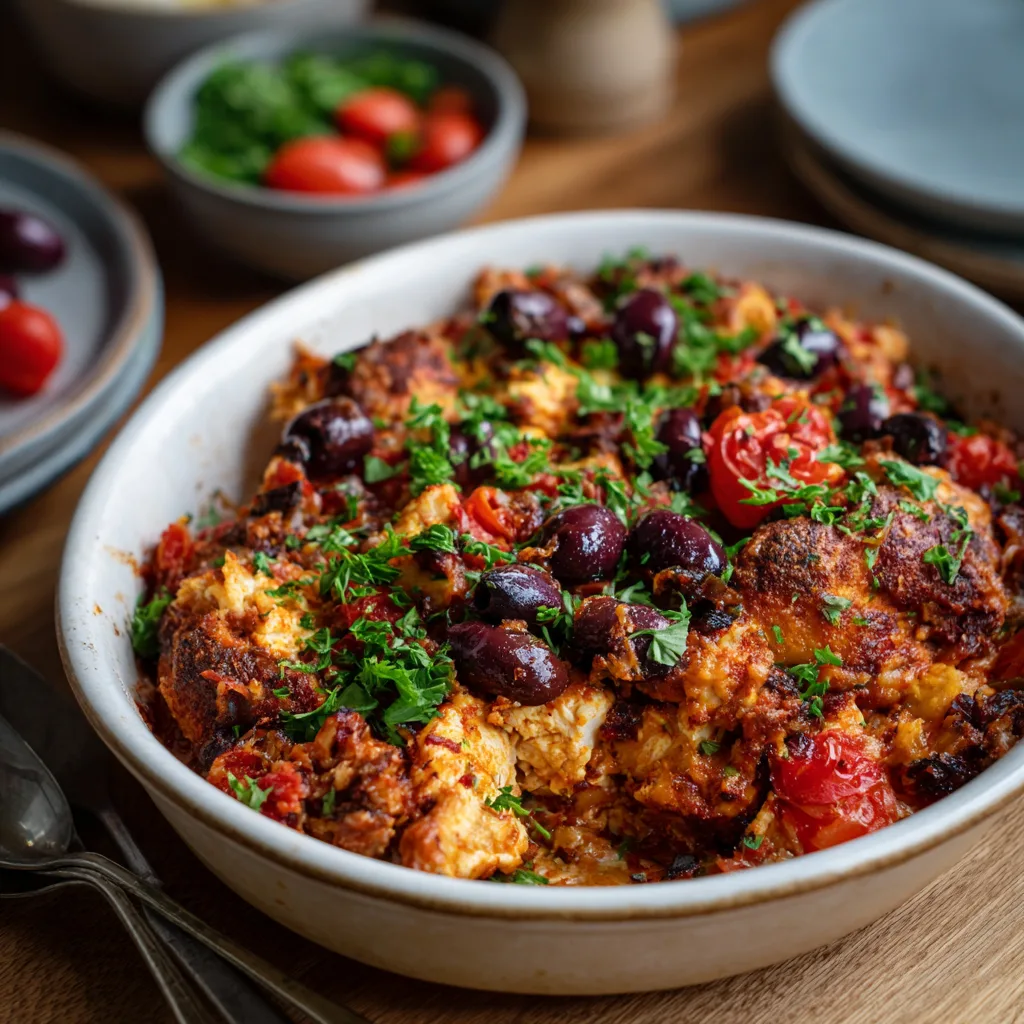What Is a Healthy Mediterranean Chicken Casserole?
A healthy Mediterranean chicken casserole blends fresh, wholesome ingredients inspired by Mediterranean cuisine. This dish typically features lean chicken, vibrant vegetables, fragrant herbs, and heart-friendly olive oil. Unlike heavy casseroles laden with cream or processed ingredients, the Mediterranean version prioritizes nutrition without sacrificing flavor. The casserole bakes all components together, creating a comforting meal that is both satisfying and nourishing.
Mediterranean dietary principles emphasize whole foods such as fruits, vegetables, whole grains, lean proteins, nuts, and healthy fats. It focuses on natural, minimally processed ingredients, balanced meals, and generous use of herbs and spices. This approach supports overall wellness and long-term health by promoting nutrient-rich and anti-inflammatory foods.
Why Choose a Mediterranean Chicken Casserole?
Opting for a Mediterranean chicken casserole means embracing a meal packed with heart-healthy fats, lean protein, and antioxidants. Olive oil, a staple in this cuisine, provides monounsaturated fats known to reduce cholesterol and improve cardiovascular health. Chicken serves as a lean source of protein essential for muscle repair and energy.
Additionally, this casserole offers convenience. It combines multiple nutritious ingredients in one dish, simplifying meal prep and saving time. Its versatility allows you to customize it with seasonal vegetables or preferred herbs. This flexibility ensures you can enjoy a delicious, wholesome dinner even on busy days.
Popular Ingredients in Mediterranean Chicken Casseroles
Key ingredients reflect the Mediterranean region’s bounty. Lean chicken cuts such as breasts and thighs provide tender, protein-rich meat that complements the other flavors. Vegetables like juicy tomatoes, crisp zucchini, colorful bell peppers, and sweet onions add texture, vitamins, and antioxidants.
Herbs and spices bring brightness and depth. Oregano, basil, garlic, and lemon zest infuse the casserole with aromatic, vibrant notes that evoke Mediterranean landscapes. For a creamy contrast, dairy elements like crumbled feta cheese or a dollop of Greek yogurt add richness without heaviness.
Whole grains such as farro, orzo, or quinoa frequently appear in these casseroles. They boost fiber content and contribute a satisfying bite, rounding out the meal with wholesome carbohydrates. Together, these ingredients create a balanced and flavorful dish that celebrates Mediterranean nutrition and taste.
Nutritional Profile of Mediterranean Diet-Inspired Casseroles
Mediterranean chicken casseroles pack a powerful nutritional punch. They provide high-quality protein from lean chicken, which supports muscle growth and repair. This protein helps you feel full longer, making it easier to maintain a healthy weight. Additionally, these casseroles include plenty of fiber-rich vegetables and whole grains. Fiber promotes digestive health and stabilizes blood sugar levels.
Another standout feature is the generous use of olive oil, a rich source of monounsaturated fats. These fats help lower bad cholesterol while raising good cholesterol, supporting heart health. Unlike many traditional casseroles, Mediterranean versions keep saturated fats low by avoiding heavy creams and butter. Processed ingredients take a backseat, replaced by natural, nutrient-dense foods that nourish the body effectively.
Disease Prevention and Longevity Through Mediterranean Chicken Casseroles
Eating Mediterranean-style casseroles regularly can contribute to reduced risks of chronic diseases. The combination of healthy fats, antioxidants, and lean proteins works synergistically to protect the heart and blood vessels. Studies show that diets rich in monounsaturated fats, like those from olive oil, can lower the risk of heart disease and stroke significantly.
Moreover, the anti-inflammatory compounds found in garlic, herbs, and vegetables help combat chronic inflammation—a root cause of many illnesses. Maintaining a healthy weight is easier with these casseroles, as they emphasize nutrient density without excess calories. Together, these factors promote longevity and overall well-being.
Mediterranean Diet’s Role in Gut Health
Fiber plays a crucial role in digestive health, and Mediterranean casseroles are rich in it thanks to vegetables and whole grains. Fiber feeds beneficial gut bacteria, improving digestion and enhancing immune function. This positive effect supports nutrient absorption and helps prevent constipation.
Fermented dairy products like Greek yogurt add probiotics to the diet. These live bacteria strengthen the gut microbiome, further boosting digestion and immunity. Incorporating yogurt or similar fermented foods into casseroles or as accompaniments enhances these benefits. This holistic approach to gut health is a hallmark of the Mediterranean diet and contributes to sustained vitality.
Selecting the Right Chicken for Your Mediterranean Casserole
Choosing the right chicken is key to a flavorful and healthy casserole. Boneless, skinless chicken breasts remain the popular choice for their lean protein and mild taste. They cook quickly and absorb herbs and spices well, making them ideal for casseroles. However, chicken thighs offer a richer flavor and stay tender even after longer cooking times. While thighs contain slightly more fat, opting for skinless cuts keeps the dish healthy without sacrificing juiciness.
Lean protein plays a vital role in casseroles by providing satiety and supporting muscle health. Including chicken ensures your casserole remains balanced and nourishing. It also complements the other fresh ingredients, tying the dish together with satisfying texture and flavor.
Choosing Vegetables: Seasonal and Local for Freshness
Vegetables bring color, nutrition, and texture to Mediterranean casseroles. Selecting seasonal and local produce ensures maximum freshness and flavor. Popular choices include ripe tomatoes, zucchini, bell peppers, onions, and eggplants. Each vegetable adds a unique taste and nutritional profile, enriching the casserole.
Balancing flavors and textures matters. For example, sweet roasted peppers contrast nicely with tangy tomatoes. Tender zucchini offers moisture while onions add slight crunch. Including a mix of soft and firm vegetables creates interest with every bite, making the casserole more enjoyable and visually appealing.
Incorporating Whole Grains for Added Nutrition
Whole grains add fiber, vitamins, and minerals to casseroles, enhancing their nutritional value. They also provide a hearty texture that complements the tender chicken and vegetables. Using whole grains helps keep you full longer and supports healthy digestion.
Popular Mediterranean grains like farro, quinoa, and orzo shine in casseroles. Farro delivers a nutty flavor and chewy texture. Quinoa cooks quickly and offers a complete protein source. Orzo, a small pasta, blends well and absorbs flavors beautifully. Choosing any of these grains boosts the casserole’s wholesomeness while adding satisfying substance.
Flavoring with Mediterranean Herbs and Spices
Herbs and spices define the character of a Mediterranean chicken casserole. Essential herbs include oregano, basil, and thyme. These bring warmth, earthiness, and brightness to the dish. Fresh or dried herbs both work well, but fresh herbs can add an extra burst of aroma.
Garlic plays a starring role by infusing a savory depth. It pairs perfectly with the zesty brightness of lemon zest or juice, which lifts and balances richer flavors. Together, garlic and lemon create layers of flavor that make the casserole vibrant and enticing.
Adding Dairy for Creaminess Without Excess Calories
Dairy adds a creamy texture and slight tang, enhancing the casserole’s complexity. Crumbled feta cheese offers a salty richness that pairs perfectly with herbs and vegetables. It melts slightly during baking, coating ingredients in a luscious layer without overpowering them.
Greek yogurt serves as another excellent option. It can be stirred into the casserole before baking or dolloped on top afterward. Yogurt contributes creaminess and beneficial probiotics while keeping calories in check. Both feta and Greek yogurt help balance richness with lightness, making the casserole satisfying but not heavy.
Classic Mediterranean Chicken Casserole: Timeless Flavor and Tradition
The classic Mediterranean chicken casserole features time-honored ingredients like lean chicken, ripe tomatoes, olives, bell peppers, onions, and fragrant herbs such as oregano and thyme. Preparation begins by sautéing the chicken and vegetables briefly to develop flavor. Then, everything combines in a baking dish with olive oil and seasonings, allowing the ingredients to meld in the oven.
This traditional method ensures tender chicken and perfectly roasted vegetables. The feta cheese often tops the casserole toward the end of baking, adding a creamy, salty finish. This straightforward recipe highlights fresh, wholesome ingredients and captures the essence of Mediterranean home cooking with balanced nutrition and satisfying taste.
Low-Carb and Keto-Friendly Mediterranean Casserole Variations
For those following low-carb or keto diets, the classic casserole adapts easily. Substituting grains like farro or orzo with cauliflower rice or spiralized zucchini noodles cuts down on carbohydrates significantly. Cauliflower rice mimics the texture of grains while adding fiber and nutrients.
Adjusting ingredients can include reducing starchy vegetables and increasing healthy fats such as olive oil or adding avocado slices on the side. Using higher-fat dairy like full-fat feta or Greek yogurt maintains richness without relying on carb-heavy components. These modifications keep the casserole flavorful and filling while fitting strict dietary needs.
Vegetarian and Plant-Based Mediterranean Casserole Options
Vegetarian and plant-based eaters can enjoy Mediterranean casseroles by replacing chicken with protein-packed legumes like chickpeas or lentils. These ingredients bring heartiness and a subtle nutty flavor that complements the vegetables and herbs.
To ensure a balanced protein profile, combining legumes with whole grains such as quinoa enhances the dish’s nutritional value. Incorporating plant-based dairy alternatives like vegan feta or cashew-based cream adds creaminess while keeping the casserole fully plant-powered. With these swaps, the casserole remains rich in taste and satisfying, catering to diverse dietary preferences.
Meal Prep and Freezer-Friendly Mediterranean Casserole Tips
Mediterranean chicken casseroles are ideal for meal prep due to their ease of assembly and excellent reheating properties. Preparing the casserole a day in advance allows flavors to deepen and saves time on busy days. Store portions in airtight containers for convenient grab-and-go meals.
For freezing, assemble the casserole but hold off on adding dairy toppings like feta to preserve texture. Freeze in portion-sized containers and thaw overnight in the refrigerator before reheating. Reheat gently in the oven or microwave to maintain moisture and flavor. These tips ensure your casserole stays delicious and nutritious even after storage, making it perfect for busy lifestyles.
Ideal Side Dishes to Complement Your Mediterranean Chicken Casserole
Pairing your Mediterranean chicken casserole with fresh, vibrant side dishes enhances the meal’s overall appeal. Classic Mediterranean salads such as Greek salad, featuring cucumbers, tomatoes, olives, and feta, bring a crisp and refreshing contrast. Another great option is tabbouleh—a parsley and bulgur salad bursting with lemon and mint flavors—that adds brightness and texture.
Roasted vegetables like asparagus, eggplant, or carrots provide warmth and depth, while steamed greens such as spinach or kale offer a nutritious, tender complement. These sides keep the meal balanced and add layers of flavor without overwhelming the palate.
Non-Alcoholic Beverage Pairings to Refresh the Palate
For a refreshing beverage, sparkling water infused with a squeeze of lemon or fresh herbs works wonderfully alongside the casserole. These light options cleanse the palate between bites and harmonize with the dish’s fresh and zesty flavors. Infusing water with cucumber or mint also adds a cooling twist that complements Mediterranean cuisine perfectly.
Garnishing and Presentation Tips for a Beautiful Mediterranean Meal
Finishing touches make a meal memorable. Fresh herbs like chopped parsley or mint scattered over the casserole add vibrant color and a burst of herbal aroma. A final drizzle of high-quality extra-virgin olive oil brings a silky sheen and enhances richness.
A squeeze of fresh lemon juice right before serving lifts all the flavors and adds a zesty brightness that ties the entire dish together. These simple garnishes elevate your casserole from everyday to exceptional, making it a feast for both the eyes and the taste buds.
Frequently Asked Questions (FAQs)
Can I use chicken thighs instead of breasts?
Yes, chicken thighs add juiciness and richer flavor while keeping the casserole tender.
How can I make this casserole spicier?
Add red pepper flakes or a diced jalapeño to the vegetable mixture for a mild kick.
Can I prepare this casserole ahead of time?
Absolutely. Assemble it and refrigerate overnight before baking to save time.
Is this recipe suitable for meal prepping?
Yes, it stores well in airtight containers for easy meals throughout the week.
Can I add other vegetables to this casserole?
Feel free to include zucchini, eggplant, or spinach to boost nutrition and variety.
Healthy Mediterranean Chicken Casserole Recipe – Nutritious & Flavorful

A wholesome and flavorful casserole combining lean chicken, vibrant vegetables, and aromatic herbs, baked to perfection for a satisfying meal.
Ingredients
- 4 boneless, skinless chicken breasts, cubed
- 2 cups cherry tomatoes, halved
- 1 cup Kalamata olives, pitted and halved
- 1 medium red onion, thinly sliced
- 1 medium bell pepper, thinly sliced
- 4 cloves garlic, minced
- 1 tablespoon dried oregano
- 1 teaspoon dried thyme
- 1 teaspoon dried basil
- 1 teaspoon paprika
- Salt and pepper to taste
- ¼ cup extra-virgin olive oil
- ¼ cup crumbled feta cheese
- Fresh parsley, chopped (for garnish)
Instructions
Notes




